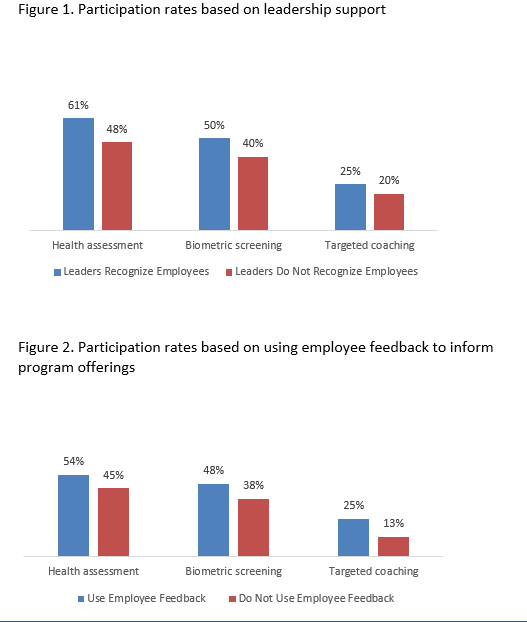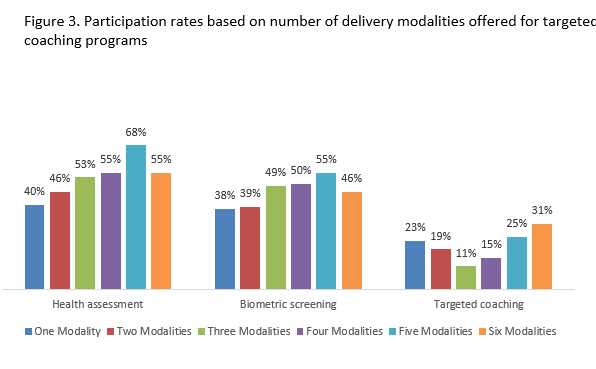
Authored by Elissa Rosenbaum
CEBS; Senior Associate, Total Health Management, Mercer
Companies and consultants alike are always searching for the next “silver bullet” that will drive employee participation, asking questions such as:
- How much incentive money is needed to increase participation in programs?
- How do we engage our leaders to promote our programs when they have so many other responsibilities?
- What does it take to get someone to take action to improve their health?
- Do we have the right members in the right program?
- And what’s the right mix of strategies to make an impact?
Employers want higher participation rates because even the most effective programs won’t be impactful if not enough of the right people are exposed to them. The HERO Health and Well-being Best Practices Scorecard in Collaboration with Mercer© (HERO Scorecard) assesses the use of strategies to drive participation in wellness activities (e.g., incentives, leadership support, and different delivery modalities or choices) and also collects information on organizations’ participation rates. This commentary examines which strategies we’ve found to be associated with higher participation rates.
Data from 623 organizations that completed the HERO Scorecard were analyzed to determine how specific practices influenced participation rates in health assessments, biometric screening, and interactive health coaching programs. A preliminary review of respondents’ self-reported participation rates revealed a small number of organizations with extremely low or high participation. Therefore, this analysis consistently relies on medians as a measure of central tendency rather than means. The median represents the value at which half of the responding companies are distributed above it and half below.
Nearly 300 (n=296) organizations provided participation data on their health and well-being programs. Of these employers, 43% reported high participation in at least one program element, including health assessment, biometric screenings or coaching. The analysis that follows examines how specific practices were associated with participation rates in those program elements. For the purposes of this analysis, “high participation” is defined as the point at which the top third of employers are distributed: 70% for health assessment; 66% for biometric screening; and 39% for coaching programs.
Organizational and Leadership Support
The practice most associated with higher participation rates is having leadership that publically recognizes employees for their wellness efforts and achievements (see figure 1). Such organizations report participation rates of 61% for health assessment (versus 48% when leaders do not recognize employees), 50% for biometric screenings (versus 40%) and 25% for targeted coaching programs (versus 20%). When leaders serve as role models by actively participating in health and well-being programs, participation rates tended to be similarly distributed. Using employee feedback to inform decision making about health and well-being content and program offerings is also associated with higher participation rates in health assessment (54% with employee input versus 45% without input), biometric screening (48% versus 38%) and health coaching (25% versus 13%) – (see figure 2).

Choice
Behavioral science research suggests that the availability of choice can increase individual action, but that too many choices can cause choice paralysis – leaving individuals unable to determine which is the “right choice.” Offering choice in delivery modality is a way to present options on which people can act in a familiar setting using a format they prefer. One question in the HERO Scorecard asks what delivery options are available for targeted health coaching programs. Some respondents offered as many as six choices: phone, email or mobile SMS, web-based, on-site one-to-one, on-site group, and interactive paper-based. When participation rates were examined based on the number of coaching choices offered, more choices were associated with higher participation rates (see figure 3). Health assessment participation rates increased with each additional delivery choice that was offered until the highest choice level where the rate dropped (40% for one choice, 46% for two, 53% for three, 55% for four, 68% for five, and 55% for six). Biometric screening participation rates increased in a similar fashion (38% for one choice, 39% for two, 49% for three, 50% for four, 55% for five, and 46% for six). This pattern was not observed for coaching participation, which increased at the two highest choice levels (23% for one choice, 19% for two, 11% for three, 15% for four, 25% for five, and 31% for six). Much more research needs to be done to fully understand the role of choice on participation rates.

Thirty-eight percent of companies completing the HERO Scorecard reported using intrinsic motivation as the primary focus for their participation strategy; in other words, these employers sought to create a strategy focused on increasing the internal value employees associate with health, independent of any direct financial reward. Respondents that relied on intrinsic motivation strategies as a primary focus did not appear to have higher participation rates than companies using them as a support to other strategies, such as extrinsic motivators. Because inadequate information is provided on the HERO Scorecard to understand what additional strategies were used by organizations relying primarily on an intrinsic motivation strategy, more research needs to be done in this area.
Financial Incentives
Nearly two-thirds of respondents (65%) provide a financial reward or penalty in connection with a health management program, 15% provide only token incentives, and 20% of companies offer no incentives of any kind. Clearly, a sizable majority of employer well-being programs continue to rely upon extrinsic motivating factors to encourage action. Consistent with numerous published research studies, companies that offer large financial incentives tend to report higher participation rates than companies offering smaller incentive amounts. To examine alternative strategies for increasing participation, this analysis targeted companies with no, token, or small financial incentives ($100 or less annually per employee for any type of incentive) that reported high participation rates.
The data suggest that large financial incentives are not the only way to encourage participation. Employers can leverage modest incentives to gain high participation rates with the right mix of programmatic and organizational support. There were 16 companies in the HERO Scorecard database that reported offering small or no financial incentives that had high participation rates for health assessment, biometric screenings or targeted health coaching. When analyzing this group’s use of strategies, more than half of the group relied on one or more of the following practices: branded communications with a unique program name, logo, and tagline; collecting employee input on program content and delivery; group goal setting or activities with a common goal; and competitions or challenges. While 16 organizations is too small of a group to conclude that the identified strategies will drive high participation rates in all organizations, the findings suggest possible practices to augment the use of financial incentives alone.
Conclusion
Employers can combine intrinsic and extrinsic motivation with other program strategies to drive program participation. Practices that drive higher participation include leadership support through role modeling and employee recognition, providing multiple modalities to access programs, using branded communications to promote programs, developing wellness champion networks, and incorporating social elements into programs. Financial incentives continue to be a primary mechanism many employers rely on to drive participation, but combinations of intrinsic incentives and other program strategies may yield comparable results.
Further research is needed to determine the right mix of strategies to optimize participation in health and well-being programs.
This commentary is based on data from the HERO Scorecard Benchmark Database through December 31, 2016.
Elissa Rosenbaum is a senior associate with Mercer’s Total Health Management team. She received a bachelor of arts in statistical mathematics from Washington University in St. Louis and is a licensed insurance producer with a Certified Employee Benefits Specialist designation. Elissa works with jumbo employers to implement holistic design strategies and data-driven decision making.

Comments are closed.
It’s been my personal experience that seeing the top level executives actively taking part in corporate health programs makes a HUGE impact on employee participation. Like, double the participation. Leadership by example is powerful.